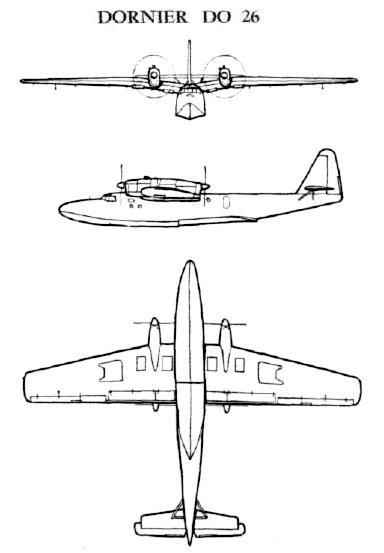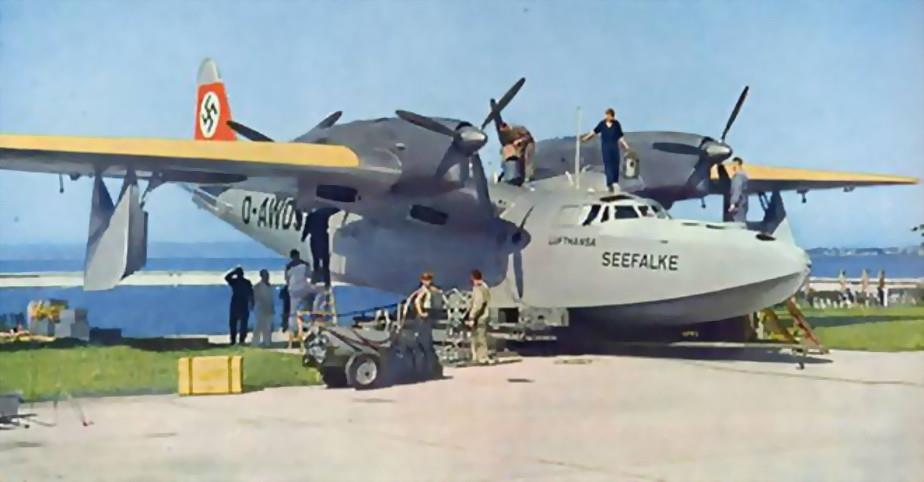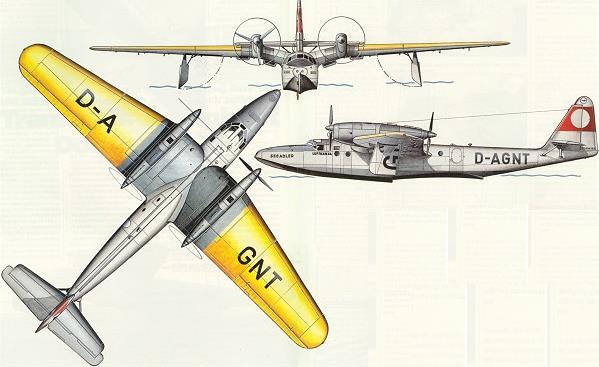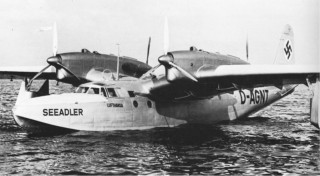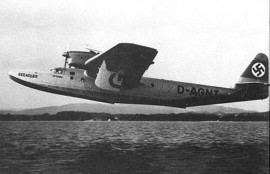| Type |
A (V1, V2) 4 seat mail carrier (later with 2 - 4 passengers) |
B (V3) 4 seat transport ( Up to 8 passengers |
C (Rebuilt V3 and V4 - V6) Military transport |
| Engine |
4 Junkers Jumo 205E |
4 Junkers Jumo 205Ea |
4 Junkers Jumo 205D |
| Dimensions |
Length 24,6 m, height 6,85 m , span 30,0 m , wing area 120 m2 , |
| Weights |
Empty 10200 kg, loaded 17000 kg, from catapult 19000 - 20000 kg, max. take off weight fuel 7300 l, oil 600 l |
Empty 11800 kg, loaded 21000 kg from catapult, max. take off weight
|
Empty , loaded , max. take off weight |
| Performance |
Max.. speed 335 km/h , cruising speed 305 - 310 km/h, range 9000 km, endurance , service ceiling 4800 m , climb |
Max.. speed 320 km/h, cruising speed 292 km/h , range 6300 km, endurance , service ceiling 3900 m , climb |
|
| Armament |
Armament in Luftwaffe service : 1 MG 151 in the bow, 2 MG 15 in dorsal position and 1 MG 15 in the aft fuselage |
| Type |
Werk.Nr |
Registration |
History |
| V1, A |
791 |
D-AGNT, P5+AH |
"Seeadler". First flight 21/5 1938 (Pilot Erich Gundemann).First catapult launch 22/11 1938. To Lufthansa, made a long distance flight in Febr. 1939 to Chile Modified with a passenger cabin (4 passengers). Used in the South Atlantic before the war as a mail carrying transport. Totally 18 flights together wth the V2. To Luftwaffe in Sept. 1939, KGr.z.b.V. 108. Destroyed at Rombakkenfjord, Norway on 28/5 1940 by english fighters (Hurricanes from 48 (F) Squadron) |
| V2, A |
792 |
D-AWDS, P5+BH |
"Seefalke". First flight 23/11 1938.Accepted by Lufthansa spring 1939. Modified with a passenger cabin (4 passengers). To Luftwaffe in Sept. 1939, KGr.z.b.V. 108. Shot down 9/5 at Tepkölenfjord, Norway. The crew including Graf Schack was captured by the English. |
| V3, B |
793 |
D-ASRA, P5+CH |
"Seemöwe". First flight 16/8 1939. To Luftwaffe in Sept. 1939, KGr.z.b.V. 108. Destroyed at Rombakkenfjord, Norway on 28/5 1940 by english fighters (Hurricanes from 48 (F) Squadron) |
| V4, C |
794 |
P5+DH |
To Luftwaffe , KGr.z.b.V. 108.Later to Erprobungsstelle Travemünde. Still in use 1944 |
| V5, C |
795 |
P5+EH |
To Luftwaffe in , KGr.z.b.V. 108.Later to K.Fl.Gr. 406. Crashed 16/11 1940 after a catapultstart from the Friesenland at Brest. The crew was killed |
| V6, C |
796 |
P5+FH |
To Luftwaffe. To Erprobungsstelle Travemünde. Still in use 1944 |
The Do 26 was of all-metal construction. The hull had a central keel and a defined step; the wings were of gull wing configuration, the outer sections being equipped with fully retractable narrow stabilising wing-floats, instead of Dornier's famous "water-wing" sponsons extending from the lower hull for lateral stabilization.
Its four engines, Junkers Jumo 205C diesels, were mounted in tractor/pusher pairs in tandem nacelles located at the joint between the dihedral and horizontal wing sections. The rear (pusher) engines could be swung upwards through 10° during take-off and landing, to prevent contact between the three-blade airscrew and water spray created by the forward propellers.
The tail unit was of conventional design, comprising a horizontal tailplane and a single, vertical fin with rudder.
In 1937, Deutsche Lufthansa ordered three Do 26 aircraft, which were designed to be launched by catapult from special supply ships, for transatlantic air mail purposes. The first, Do 26A D-AGNT V1 Seeadler ("Sea eagle"), was piloted on its maiden flight by Flight Captain Erich Gundermann on 21 May 1938; D-AWDS V2 Seefalke ("Sea Falcon"), followed on 23 November 1938, piloted by Flight Captain Egon Fath. Both were completed and handed over to Deutsche Lufthansa before the outbreak of World War II. Due to opposition from the United States, the German airline was unable to operate these aircraft on the intended transatlantic route; instead, in 1939 they were used to carry air mail between Bathurst and Natal on the Southern Atlantic route.[citation needed] The third aircraft, Do 26B D-ASRA Seemöwe ("Seagull") was completed shortly before the start of World War II.
One Do 26 civilian mission was carried out by V2 Seefalke, when on 14 February 1939 the veteran Deutsche Lufthansa pilot Flight Captain Siegfried Graf Schack von Wittenau embarked on a mercy flight to Chile, taking 580 kg (1,279 lb) of medical supplies for earthquake victims in Chile. The 10,700 km (6,600 mi) flight between Lisbon and Rio de Janeiro lasted 36 hours.
All three Deutsche Lufthansa aircraft were impressed into military service in 1939 at the outbreak of World War II, as P5+AH, P5+BH and P5+CH respectively]
Three other Do 26 aircraft (V4 – V6) were built as Do 26 C for the Luftwaffe with the more powerful 648 kW (880 hp) Junkers Jumo 205D engines; the original three aircraft were similarly converted for military service. Armament consisted of one 20 mm MG 151/20 cannon and three 7.92 mm (MG 15 machine guns.
Allocated initially to KüFlGr (Küstenfliegergruppe/Coastal Aviation Group) 406 (later 506),[2] the Do 26s saw service in April and May 1940 in the Norwegian Campaign, transporting supplies, troops and wounded to and from the isolated German forces fighting at Narvik under the command of General Eduard Dietl. During this campaign three of them were lost:
On 8 May 1940, V2 (ex Seefalke) was shot down by three Blackburn Skuas of 803 Naval Air Squadron, Fleet Air Arm, operating from the Royal Navy aircraft carrier HMS Ark Royal while carrying 18 Gebirgsjägers to the Narvik front. After a running fight V2 crash-landed in Efjorden in Ballangen Municipality. Siegfried Graf Schack von Wittenau, the crew and 18 soldiers, were captured in bloody fighting with Norwegian forces. One of the Skuas, flown by future Fleet Air Arm fighter ace Sub-Lieutenant Philip Noel Charlton,was hit by return fire from V2 and made an emergency landing at Tovik near Harstad.
Then, on 28 May 1940, both V1 (ex Seeadler piloted by Ernst-Wilhelm Modrow) and V3 (ex Seemöwe) were set ablaze with gunfire and sunk at their moorings at Sildvik in Rombaksfjord near Narvik, when discovered and attacked by three Hawker Hurricanes of No. 46 Squadron RAF led by the New Zealander Flight Lieutenant (later Group Captain) P.G. "Pat" Jameson, DSO, DFC and bar shortly after landing. Three mountain guns destined for the German forces fighting in the mountains east of Narvik were lost with the destruction of V1 and V3,[whilst one gun was unloaded from one of the aircraft before it was lost.
V5 was lost on 16 November 1940, killing its crew, after being launched at night from the catapult ship Friesenland[9] in Brest, France. The fate of V4 and V6, which in 1944 were still assigned to the Test Unit (German: Erprobungsstelle) in Travemünde, is unclear.
